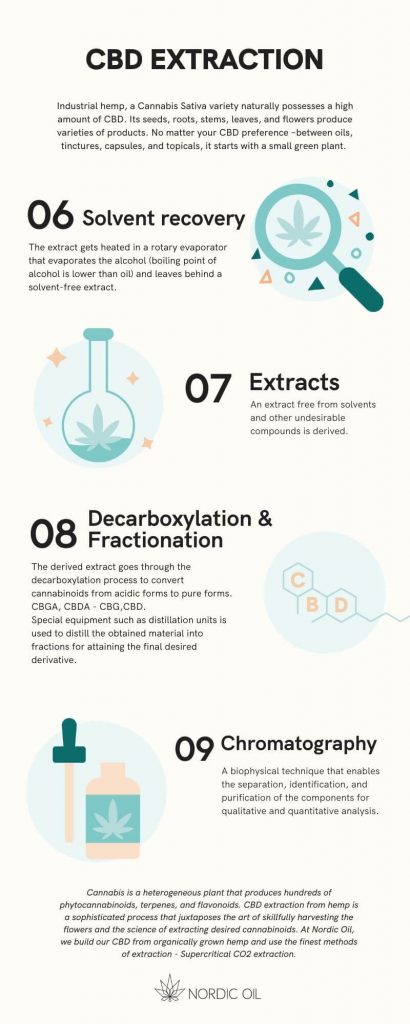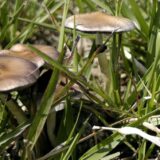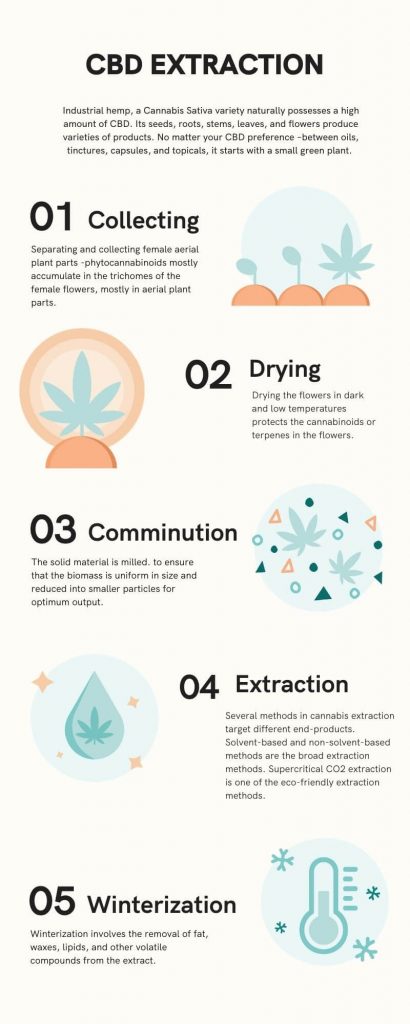- The Cannabis Sativa plant – a quick review
- Extraction Goal
- Growing and Harvesting – the Green Standard
- Is cannabis extraction legal?
- Biomass: Pre-processing stage
- Steps involved in cannabis extraction
- Different methods to extract CBD
- CO2 extraction method
- How is CBD extracted? The process of CO2 extraction
- Quick takeaways
How do we at Nordic Oil start our CBD from leafy green organic hemp plants and finish with a golden extract? Let’s deep dive into this journey.
Many people can recognize cannabis by the distinct look of the cannabis plant’s leaves. As for CBD oil, there are numerous offerings on the web for any variety and combination of CBD and other cannabinoid-based products. Whether you work with or consume Cannabis or CBD, the cannabis plant has circulated outside of pop culture films into the lab. From here additions have been made across brands with many cosmetics, fabrics, and dietary supplement providers.
When you choose Nordic Oil, you may trust that we build our CBD from organically grown hemp, and use the finest methods of extraction. Following our selective and abundant hemp harvest are several stages required to ensure the highest quality CBD oil.
Our golden extract is made by a consistently thorough process. Read on to get to know our stages in this process – beginning from lush green leaves to finish at a pure, golden extract.
The Cannabis Sativa plant – a quick review
Let’s briefly review what we discussed in our post ‘what is CBG?’ to get a quick overview of the different chemotypes.
Hemp belongs to the family of Cannabaceae, which has been divided into three subspecies, Sativa (fiber), indica (psychotropic), and the debated third sub-species, ruderalis.
For many cultivators seeking to appeal to consumers, the hybrid of indica-sativa is well renowned for its medicinal properties. The fiber-type quality of the Cannabis Sativa species is based on their cannabinoid composition and develops into five subspecies. These are used in the manufacturing of food, medicinal and recreational products, textile, and commercial products respectively.
Extraction Goal
Cannabis sativa is a highly versatile plant where every part of the plant including its seeds, roots, stems, leaves, and flowers produces varieties of end products that can be made into products of economic interest.
To cite a few examples, hemp seed or grain, flour and hemp oil, hemp fibers, and fiber hemp products are transformed into end products such as textile, cordage and paper, bio-building and thermal insulating materials, and bioactive compounds of pharmacological interest. Hemp has been shown to be a sustainable source for all kinds of goods.
Therefore the term ‘extraction’ throughout the hemp industry determines the end product. Moreover, the latest review study asserts that the requirements of the entire hemp industry may be classified into two broad categories.
- Trichomes: From one of our previous blog post on THC, we learned that trichomes contain abundant cannabinoids. Therefore, manufacturers head towards the trichomes for extracting cannabinoids and terpenes, with the goal of deriving medical or recreational grade supplements.
2. Seeds: Seed extracts produce fatty acids or lipids. A 2014 study confirms that about eight triglycerides and high amounts of palmitic acid can be extracted from hemp seed oil. A 2006 study, reports that hempseed oil contains high amounts of essential fatty oils, linoleic acids, and alpha-linolenic acids.
The extraction goal, the scale of production, final derivative, and several other need-based parameters are what manufacturers determine and subsequently modify. It is an individual choice to determine what the extraction process will look like. Now, let us dive into understanding the complex extraction process.
Growing and Harvesting – the Green Standard
No matter your CBD preference –between tinctures, capsules, and topicals: If it’s a full spectrum product, it usually all starts with a small green plant. The hemp plant itself is unique, as it can grow across different climates and locations. Depending on the season of harvest, and the climate in the area, the color of the extract at the end is prone to change.
Both hydroponics and greenhouses are used for hemp harvests, as there is more control over maintaining organic growing practices. The use of greenhouses and hydroponic growing are modern and are more accessible to those who wish to grow in cities, and aid in sustainable harvests. Whether the plants are harvested by hands, or a machine ultimately depends on the scale of the growers.
Is cannabis extraction legal?
The 2018 US Farm Bill and the 2020 judgment of the European court of justice were game-changers to the hemp industry. We take a deep dive into the subject in our articles “Is CBD Legal in North America?” and “CBD in the EU” and discuss what led to the subsequent changes to the scheduling of hemp (the CBD-friendly plant) and cannabis.
In December of 2018 Cannabidiol, and cannabis plants containing low amounts of THC were removed from the definition of marijuana in the Controlled Substances Act (CSA) by the Food and Drug Administration (FDA). This authorized the FDA’s standards to set federal guidelines for farmers and producers to authorize sales and production of CBD products containing no more than 0.3% THC. This change came about due to the FDA approving the drug Epidiolex for treating two rare and severe seizures in children two years of age, and older.
Since the Farm Bill 2018, hemp cultivation has been a growing sector across North America, as well as in Europe in the last 5 years.
Biomass: Pre-processing stage
The foremost important step is separating the harvested plants. Once the harvested plant is dried, the stems, stalks, leaves, and flowers are separated, trimmed by hand, and assorted.
The flowers are dried (in the absence of sunlight) and milled (to reduce size). The milled biomass is ready for extraction.
*Biomass refers to the mass of living organisms of the plants, leaves, twigs, tissues, branches, boles, rhizomes, etc.
Steps involved in cannabis extraction
To make these complicated steps more understandable, we created a visual for you with the different steps:

Different methods to extract CBD
As discussed above, cannabis is a diverse plant that produces hundreds of phytocannabinoids, terpenes, and flavonoids. Moreover, the end product of the plant compounds results in different consistencies and viscosities depending on the method of extraction. Therefore, different extraction methods are adopted depending on the desired derivative or end product.
Below is the broad classification of regularly used extraction methods for Cannabis.
| Solvent-based extraction | Non-Solvent based extraction |
| Ethanol or alcohol | Ice water |
| CO2 | Cold-pressed |
| Focussed Ultrasound extraction(FUSE) | Rosin pressed |
| Hydrocarbon | Hand-pressed |
| Vegetable oil |
Supercritical CO2 extraction and its benefits:
In this blog post, we would like to focus on discussing in detail this extraction method, as Nordic Oil CBD products go through this process for the following benefits:
- CO2 extraction is one of the most popular and eco-friendly methods of extraction and is one the most gentle and thorough forms.
- A wide variety of industries such as food, beverage, cosmetics, and pharmaceuticals use this technique.
- This process retains the most plant nutrients in comparison to other methods of extraction.
Although the requirement of sophisticated equipment, training, and operation makes it an expensive extraction process, the end product is pure and potent. The final product is free from harmful solvents or residues.
CO2 extraction method
A closed-loop extractor is the extraction equipment used for this process that has three chambers:
- Chamber 1: contains pressurized, liquid CO2
- Chamber 2: to fill cannabis biomass
- Chamber 3: releases the extracted product
Using pressurized carbon dioxide in different temperatures and states of matter, the desired compounds are extracted from the plant.
- Supercritical- The pressure of carbon dioxide is made to reach a maximum supercritical point which facilitates the gas to retain its gas as well as liquid state.
- Subcritical – Here, the pressure and temperature of CO2 is maintained at a low level throughout the extraction process.
- Mid Critical – A medium pressure that falls in between the supercritical and subcritical, and a standard temperature range is maintained in mid critical method.
How is CBD extracted? The process of CO2 extraction
- In the first step, the vessel for extraction is filled with carbon dioxide, where it is cooled and compressed, facilitating it into liquid carbon dioxide. The temperature and pressure is monitored and maintained.
- The pressure in the chamber is increased so that CO2 could reach its supercritical state, to be able to simultaneously retain its gaseous and liquid state. This midway state of CO2 is now ready to merge with the cannabis biomass, where the density of the liquid enables extraction and the gas in the closed loop contains the vapor inside the chamber bringing out the active compounds from the hemp biomass.
- Chamber 2 is filled with hemp biomass. The CO2 passes through the plant material, dissolving the cannabinoids and terpenes.
- The CO2 solvent, now carrying active constituents, is put through the next chamber where it loses its liquid state and flashes into a gas. Since the extracted CBD is denser, it falls down to the bottom of the vessel and gets collected. The carbon dioxide in the gaseous state is sent back to the first chamber to be condensed again (for reuse).
- Finally, an extract rich in CBD is separated and collected.
The entire process can last between 2-24 hours which makes it very time-consuming and expensive, but also ensures a high-quality hemp extract.
Last but not least, all our CBD products undergo extensive and conclusive testing for quality control, offering public access to our COAs across all our webshops.
Quick takeaways
- CBD extraction from hemp is a sophisticated process that juxtaposes the art of skillfully harvesting the flowers and the science of extracting desired cannabinoids.
- Cannabis is a heterogeneous plant that produces hundreds of phytocannabinoids, terpenes and flavonoids.Henceforth, the extraction goal, the scale of production, final derivative, and several other need-based parameters, manufacturers determine/modify the choice of the extraction process.
- At Nordic Oil, we build our CBD from organically grown hemp, and use the finest methods of extraction – Supercritical CO2 extraction.
- CO2 extraction is one of the most popular and eco-friendly methods of extraction. The CBD oil derived from this process is pure, potent and free from harmful solvents or residues.



















